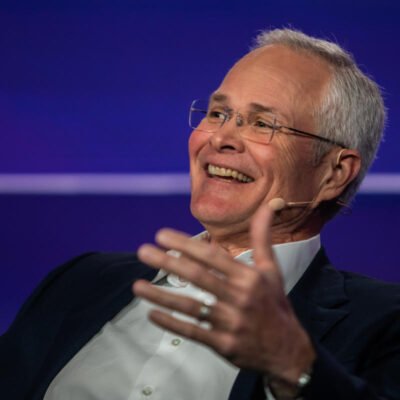Omega Healthcare Investors, Inc. (NYSE:OHI) Q1 2024 Earnings Call Transcript May 3, 2024
Omega Healthcare Investors, Inc. isn’t one of the 30 most popular stocks among hedge funds at the end of the third quarter (see the details here).
Operator: Greetings, and welcome to the Omega Healthcare Investors First Quarter 2024 Earnings Conference Call. [Operator Instructions] As a reminder, this conference is being recorded. I would now like to turn the conference over to Michele Reber. You may begin, Michele.
Michele Reber: Thank you, and good morning. With me today is Omega’s CEO, Taylor Pickett; COO, Dan Booth; CFO, Bob Stephenson; and Megan Krull, Senior Vice President of Operations. Comments made during this conference call that are not historical facts may be forward-looking statements such as statements regarding our financial projections, potential transactions, operator prospects, and outlook generally. Factors that could cause actual results to differ materially from those in the forward-looking statements are detailed in the company’s filings with the SEC. During the call today, we will refer to some non-GAAP financial measures, such as NAREIT FFO, adjusted FFO, FAD and EBITDA. Reconciliations of these non-GAAP measures to the most comparable measure under generally accepted accounting principles are available in the quarterly supplement.
In addition, certain operator coverage and financial information that we discuss is based on data provided by our operators that has not been independently verified by Omega. I will now turn the call over to Taylor.
Taylor Pickett: Thanks, Michelle. Good morning, and thank you for joining our first quarter 2024 earnings conference call. Today, I will discuss our first quarter financial results and certain key operating trends. First quarter FAD, funds available for distribution, of $0.65 per share was better than expected, and should continue to improve as several portfolios are in the process of being transitioned, which will result in meaningful FAD upside over the next few quarters. Our dividend payout ratio, of 103%, remains slightly elevated, but should drop into the mid-90% range in the upcoming quarters. We continue to have a handful of cash basis operators, including Maplewood and LaVie, that will impact our go-forward AFFO and FAD, making full-year 2024 FAD difficult to predict.
However, longer-term, we believe all these assets, but in particular Maplewood are well-positioned to generate reliable and growing cash flows and related rent. Although first quarter AFFO of $0.68 per share was strong, we’ve elected to remain conservative with respect to our full-year guidance. And accordingly, we are maintaining our 2024 AFFO guidance between $2.70 and $2.80 per share. As Dan will discuss, key tenant occupancy and rent coverage metrics continue to improve. The under 1.0x EBITDAR coverage operator metric moved up slightly from 13.2% of total rent to 14.5% of total rent due to a 3.3% operator that moved from slightly above 1.0x coverage to slightly below 1.0x coverage, at 0.98x EBITDAR coverage. We expect this operator to eventually move back above 1.0x coverage due to state Medicaid rate increases, leaving a balance of 11.2% or below 1.0x coverage operators.
In looking at the 11.2% balance of below 1.0x operators, we can break the 11.2% into a handful of buckets. Operators representing 6.2% of the 11.2% are strong credits, and therefore payment of rent should not be an issue. Operators representing 2.2% at fourth quarter and January EBITDAR coverage above 1.0x, or are benefiting from state rate increases and operational improvements that we expect to continue on a go-forward basis. That leaves operators representing just 2.8%, consisting of eight small operating relationships. Lastly, the government has issued its final rule for skilled nursing facility minimum staffing. Unfortunately, many of the constructive industry ideas and comments that include the use of technology and certain best practices were not included in the final rule.
As there is a long lead time for the implementation of the final rule, we remain cautiously optimistic that the rule will be improved over the next couple of years. I will now turn the call over to Bob.
Bob Stephenson: Thanks, Taylor, and good morning. Turning to our financials for the first quarter, revenue for the first quarter was $243 million before adjusting for certain non-recurring items, compared to $218 million for the first quarter of 2023. The year-over-year increase is primarily the result of timing and impact of operator restructurings, transitions, and revenue from new investments completed throughout 2023 and 2024, partially offset by asset sales completed during that same period. Our NAREIT FFO for the first quarter was $153 million or $0.60 per share, as compared to $146 million or $0.60 per share for the first quarter of 2023. Our adjusted FFO was $176 million or $0.68 per share for the quarter, and our FAD was $168 million or $0.65 per share.
And both exclude several items consistent with historical practices and outlined in our NAREIT FFO, adjusted FFO, and FAD reconciliations to net income found in our earnings release as well as our first quarter financial supplemental posted to our website. Our balance sheet continues to remain strong. In the first quarter, we completed $55 million in new investments excluding CapEx, and funded the investments with balance sheet cash and issuance of $33 million in equity under our ATM program. In the first quarter, we repaid all of our outstanding HUD mortgages totaling $43 million. These repayments stemmed from the previously disclosed LaVie asset sales and transitions. We ended the quarter with over $360 million in cash on the balance sheet and over $1.4 billion in credit facility borrowing capacity.
Subsequent to quarter end on April 1, we repaid our $400 million maturing bond using balance sheet cash, April 1 rent collections, and borrowing the remaining balance on the credit facility. At March 31, 99% of our $5.1 billion in debt was at fixed rates. And our net funded debt to annualized adjusted normalized EBITDA was 5.03x. And our fixed charge coverage ratio was 3.9x. Turning to guidance, as Taylor mentioned, we affirmed our full-year adjusted FFO guidance between $2.70 and $2.80 per share. To reiterate few of the key assumptions from the last earnings call, we are assuming no change in our revenue related to operators on an accrual basis of revenue recognition. We’re assuming LaVie continues to pay at the existing rate of $1.5 million per month until completion of the portfolio restructuring and continued improvement in Maplewood’s ability to pay contractual rent.
We are assuming $82 million in asset sales related to the facilities classified as assets held for sale at the end of the first quarter. We’ve included the annual impact of our 2024 investments completed through May 2nd, as disclosed in the earnings release. We project our quarterly G&A expense to continue run between $11.5 million and $13.5 million per quarter. We assume no material changes in market interest rates as they relate to either the interest earned on balance sheet cash or interest expense charged on credit facility borrowings. Our 2024 adjusted FFO guidance does not include any additional new investments or asset sale as well as any additional capital transactions other than what was already mentioned. As several operator transitions are still in negotiations and precise timings is unknown, we continue to provide a wide range to our AFFO guidance.


As stated in yesterday’s earnings press release, in the first quarter LaVie paid approximately $4.4 million in rent. And in April, they paid $1.5 million in rent. In addition in the first quarter, we reported $100,000 in rent related to two transition LaVie facilities. And, anticipate $300,000 in rent per quarter related to that transition. Turning to Guardian, we applied the remaining $60,000 in security deposit in the first quarter. And no additional cash rent was received from Guardian. And, the portfolio has been transitioned with estimated annual rent of $5.5 million starting in mid April with a potential to increase up to $12.4 million annually. And lastly, Maplewood paid $11.3 million in rent in the first quarter. In April, Maplewood paid $3.8 million in rent.
Dan will provide additional color on these operators in his prepared remarks. And with that, I will turn the call over to Dan.
Dan Booth: Thanks, Bob, and good morning, everyone. As of March 31st, 2024, Omega had an operating asset portfolio of 866 facilities with approximately 84,000 operating beds. These facilities were spread across 73 third-party operators and located within 42 states in the United Kingdom. Trailing 12-month operator EBITDA coverage for our core portfolio as of December 31, 2023 increased to 1.33 times versus 1.28 times for the trailing 12-month period ended September 30, 2023. During the fourth quarter of 2023, our operators cumulatively recorded approximately $13.5 million in federal stimulus funds as compared to approximately $12 million recorded during the third quarter. Trailing 12-month operator EBITDA coverage would have increased during the fourth quarter of 2023 to 1.28 times as compared to 1.21 times for the third quarter when excluding the benefit of any federal stimulus funds.
EBITDA coverage for the standalone quarter ended December 31, 2023 for a core portfolio was 1.48 times, including federal stimulus, and 1.41 times, excluding the $13.5 million of federal stimulus funds. This compares favorably to the stand-alone third quarter of 1.33 times and 1.27 times, with and without the $12 million in federal stimulus funds, respectively. During the second-half of 2020, as the pandemic began to meaningfully impact our tenants’ operations, the federal government began to provide relief in the form of direct stimulus payments to virtually all nursing home operators throughout the country. Knowing that the federal stimulus dollars were intended to offer short-term relief to cash-strapped operators, Omega began to report its coverage ratios on both a before and after stimulus basis.
As federal stimulus dollars have essentially ceased, our coverage reporting beginning in the first quarter of 2024 will exclude any mention of federal stimulus funds. Occupancy for our overall core portfolio has continued to recover from a low of 74.6% in January of 2022 to 80.8% as of mid-April of 2024, based upon preliminary reporting from our operators. For comparative purposes, occupancy for our core portfolio was 83.2% for the fourth quarter of 2019, just prior to the onset of the COVID pandemic. Turning to portfolio matters, LaVie, after a considerable number of divestitures in 2023 and the first quarter of 2024, Omega’s remaining portfolio with LaVie consists of 31 facilities, which include 13 facilities in North Carolina, nine in Pennsylvania, six in Mississippi, two in Virginia, and one in Florida.
We remain in ongoing discussions with LaVie on the best overall future of each of these remaining 31 facilities. LaVie has paid approximately $1.5 million per month in rent for the last six months, including April of 2024. Maplewood, during the first quarter of 2024, Maplewood paid rent of $11.3 million. In April of 2024, Maplewood paid $3.8 million in rent. Maplewood continues to see strong performance across the portfolio, with 16 of the 17 facilities fully stabilized. Occupancy at inspired New York City is currently at 66%, while the 16 stabilized Maplewood communities are currently at 93%. Guardian, during the first four months of 2024, Omega released the remaining six facilities that were formerly Guardian assets to an unrelated third party.
This concludes our restructuring of our Guardian portfolio and our relationship overall. In addition to the aforementioned restructurings and transitions, Omega is working with several other relatively small operators on various restructurings. Turning to new investments, during the first quarter of 2024, Omega completed a total of $75 million in new investments, comprised of $41.2 million in real estate loans, $13.3 million in real estate acquisitions, and $20.5 million in CapEx investments. The new loans have a weighted average interest rate of 9.6%. The new acquisitions have a weighted average annual yield of 9.8%, with 2.5% annual escalators. Subsequent to the first quarter of 2024, Omega closed on $165 million in new investments, comprised of $71.7 million in real estate loans and $93.7 million in acquisitions.
The $71.7 million in loans were made to an existing U.K. operator and bear an interest rate of 10%. The subsequent acquisitions include a $62.7 million sale leaseback transaction whereby Omega acquired 32 care homes in the U.K. and leased them back to a new operator and an initial cash yield of 10%, with 2.5% escalators, and a $31 million sales leaseback transaction whereby Omega acquired one facility in Michigan and leased it back to an existing operator at an initial cash yield of 11.5% with annual escalators of 2%. Year-to-date, Omega has closed on $240 million in new investments. I will now turn the call over to Megan.
Megan Krull: Thanks, Dan, and good morning, everyone. The staffing mandate was finalized in April despite the fact that a majority of facilities in the United States do not currently meet the requirement, and that CMS provided for no funding mechanism. And although there is a delayed implementation based on urban versus rural, other than a very limited waiver exception, no adjustments were made in the final rule to take into consideration the wide variability of access to staffing across geographic regions or the actual acuity level of residents at any given building. The rule stayed largely unchanged from what was initially proposed despite calls for LPNs to be used to cover some of the proposed requirements, and for the 24-7 RN requirement to be covered by telehealth or on-call RN support.
Instead, the one change that was made was to increase the overall hours from 3.0 to 3.48, with the additional 0.48 added to be covered by any mix of RNs, CNAs, or LPNs. That overall number is to take effect in two years for urban facilities, and three years for rural. Unchanged from the proposed rule were the 24-7 RN requirement going into effect in two years for urban facilities, and three years for rural, and the required 0.55 and 2.45 hours per resident day for RNs and nursing aids, respectively, going effect in three years for urban facilities, and five years for rural. As a reminder, while there is obviously a longer-term impact that this mandate could have on the industry, the impact is negligible in the near-term given the delayed implementation.
A lot can happen in the two years until the first set of requirements is set to be enforced. In addition to bipartisan legislation that has already been introduced in Congress and the potential for legal action, there is also the potential that additional rulemaking will change the mandate in the coming years. And irrespective of all that, at the end of the day, as has been the primary focus on reimbursement over the last couple of years related to inflation, the states, in this case, are really the ones that will need to step up in a meaningful way if this mandate remains as is. Notwithstanding the overhang, there remains positive momentum in the fundamentals of the business. We continue to hear from our operators that agency usage is down, and in certain portfolios has been eliminated entirely.
However, the wide variation by market remains. Occupancy continues its steady improvement with a slight anticipated slowdown in the winter months, the number of core facilities recovered is now at 44%, up from the 42% reported in the third quarter. Additionally, 21% of core facilities that have not yet fully recovered are at or above 84% occupancy. I will now open the call up for questions.
See also
20 Cheapest Countries to Study Abroad and
10 Best Construction Materials Stocks To Invest In Right Now.
To continue reading the Q&A session, please click here.





